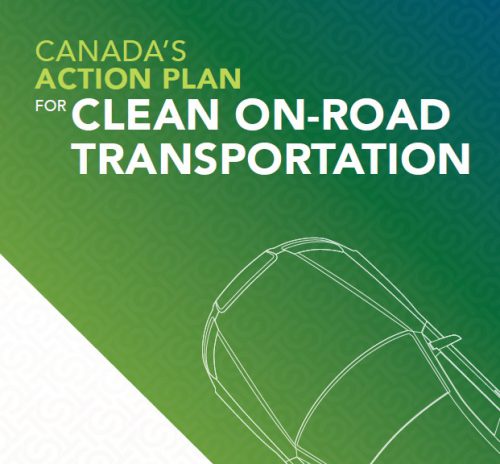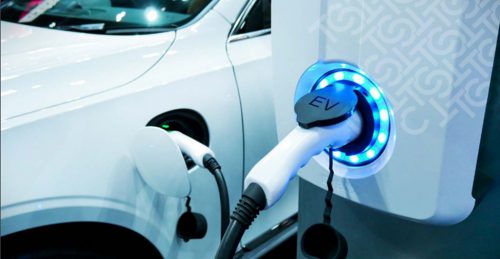
Significantly reducing emissions from on-road vehicles is key to achieve net-zero emissions by 2050.
Switching to zero-emission vehicles (vehicles that can operate with no tailpipe emissions, including battery electric, plug-in hybrid electric, and fuel cell electric vehicles) will put Canada’s transportation emissions on a downwards trajectory.
This action plan reflects the Government of Canada’s initiatives announced and implemented since 2016 to show how these measures are working together to help Canadians and Canadians businesses make the switch to zero-emission vehicles.
The Government of Canada is taking a comprehensive approach to support this transition by making significant investments in purchase incentives and charging stations. These investments will be coupled with a light-duty zero-emission vehicle sales regulation, which will set annually increasing requirements towards achieving 100% new light-duty zero-emission vehicle sales by 2035, including mandatory interim targets of at least 20% of all new light-duty vehicles offered for sale by 2026 and at least 60% by 2030.
To reduce emissions from medium- and heavy-duty vehicles, the Government of Canada will aim to reach 35% of total new medium- and heavy-duty vehicle sales being zero-emission vehicles by 2030. In addition, the Government will develop a medium- and heavy-duty zero-emission vehicle regulation to require 100% of new medium- and heavy-duty vehicle sales to be zero-emission vehicles by 2040 for a subset of vehicle types based on feasibility, with interim 2030 regulated sales requirements that would vary for different vehicle categories based on feasibility, and explore interim targets for the mid-2020s.
A focus on new vehicle sales, however, means that it will take over a decade for zero-emission vehicles to replace most vehicles on the road. Therefore, the government is also working to ensure gas and diesel vehicles already on our roads are operating as cleanly as possible. This includes initiatives to retrofit older trucks with more fuel-efficient technologies and increasing the availability of cleaner fuels.
The transition to a cleaner transportation system also represents a significant economic opportunity for the country. With its critical minerals, skilled workforce, advanced manufacturing, and low-emitting electricity grid, the Government of Canada is taking steps to cultivate a business environment where Canada is a destination of choice for investments in zero-emission vehicle manufacturing and battery value chains. This includes significant investments through the government’s Strategic Innovation Fund and reducing taxes for businesses that manufacture zero-emission technologies.
As with confronting the climate change crisis more broadly, a cleaner on-road transportation requires continued collaboration with other governments, both within and outside of Canada, as well as with automakers and other private sector partners. The government will continue to engage provinces and territories, and strengthen ties to local and regional governments, to work together to overcome barriers to greater adoption of zero-emission vehicles. The government will also strengthen efforts to consult industry, non-governmental organizations, and academia, to ensure continued progress is made towards Canada’s ambitious zero-emission vehicle sales targets. At the same time, Canada will continue to build and enhance international alliances to maintain and build global momentum towards zero-emission vehicles.
Supporting Indigenous-led opportunities to adopt zero-emission vehicles and clean fuels is important and doing so will allow Indigenous organizations and communities to develop programming that is specific to their needs. More work also lies ahead to make sure that that zero-emission vehicles are accessible to all Canadians, as this will be key to Canada’s goals of achieving net zero emissions by 2050. There will also be critical roles to play for active transportation and public transit in reducing emissions from on-road vehicles.
The shift towards low- and zero-emission vehicles need to be considered as part of a broader energy system transition, including improvements to our electrical grids to accommodate increased demand and innovations in urban planning and design.
Given the pace of change we are now witnessing in the transportation sector, the government’s approach to zero-emission vehicles will evolve over time. The Government of Canada’s future actions for cleaner on-road transportation will be detailed through the progress reports required under the Canadian Net-Zero Emissions Accountability Act, the first of which is set for 2023.
Canada’s zero-emission vehicle sales targets
The 2030 Emissions Reduction Plan set out new federal sales targets and requirements for new zero-emission vehicles and committed to:
♦ develop a light-duty zero-emission vehicle sales regulation, which will set annually increasing requirements towards achieving 100% new light-duty zero-emission vehicles sales by 2035, including mandatory interim targets of at least 20% of all new light-duty vehicles offered for sale by 2026 and at least 60% by 2030
♦ aim to reach 35% of total new medium- and heavy-duty vehicle sales being zero-emission vehicles by 2030. In addition, the Government will develop a medium- and heavy-duty zero-emission vehicle regulation to require 100% of new medium- and heavy-duty vehicle sales to be zero-emission vehicles by 2040 for a subset of vehicle types based on feasibility, with interim 2030 regulated sales requirements that would vary for different vehicle categories based on feasibility, and explore interim targets for the mid-2020s
According to projections, steady annual progress towards these targets should result in:
♦ around 395,000 new light-duty zero-emission vehicle sales in 2026, 1.2 million zero-emission vehicle sales in 2030, and 2.0 million zero-emission vehicle sales in 2035
♦ about 1.4 million light-duty zero-emission vehicles on the road by 2026, 4.6 million on the road by 2030, and 12.4 million on the road by 2035
♦ around 39,000 new medium- and heavy-duty zero-emission vehicle sales in 2030
Meeting these ambitious targets is key to reaching our goal of net-zero emissions by 2050 and will require a concerted effort by governments working closely with industry, utilities, experts, and non-governmental organizations, and responding to feedback from individual Canadians. But Canadians and Canadian businesses face many barriers to using zero-emission vehicles. Overcoming these challenges will be key to meeting our zero-emission vehicle sale targets.
Make sure zero-emission vehicles are available. Many Canadians and businesses who want to buy a zero-emission vehicle face limited availability at dealerships or long wait times. Others simply can’t find a model that suits their needs. Zero-emission vehicle inventory across Canada is also uneven as jurisdictions with incentive programs and zero-emission vehicle sale regulations are prioritized over others for the limited supply of zero-emission vehicles. Disruptions in manufacturing supply chains, including semiconductor and critical mineral shortages, further complicate the current supply situation.
Make zero-emission vehicles more affordable. Zero-emission vehicles have higher purchase prices than comparable internal combustion engine vehicles. On top of short-term inflation, high demand for the minerals used to build batteries has increased costs. Despite lower operating and maintenance costs, incentives will be key in offsetting the upfront cost differences between zero-emission vehicles and gas or diesel vehicles.
Build charging and refuelling stations. Canadians want to know that they will be able to get where they need to go, and charge or refuel their zero-emission vehicle in a way that fits their lifestyle or business needs. Uncertainty about adequate access to charging and refuelling stations, their reliability and ease of use, has been a concern for some potential buyers
Build public awareness and confidence in zero-emission vehicles. Canadians still don’t know much about zero-emission vehicles and have limited exposure to them. Awareness, training and education programs aimed at seeing and experiencing these technologies in action will help consumers discover the benefits of adopting these vehicles.
Support research, development, and demonstration (RD&D). Despite significant technological progress in recent years, there’s more work to do to accelerate innovative technologies to support the commercialization and uptake of zero-emission vehicles across most vehicle segments, particularly medium- and heavy-duty vehicles.
Lead by example. The Government of Canada continues to build a cleaner on-road transportation system while influencing others to follow suit through green procurement.
Act on clean growth opportunities. Making investments to support a vehicle manufacturing sector in Canada that is innovative and competitive, while also protecting jobs as the automotive sector transitions.

